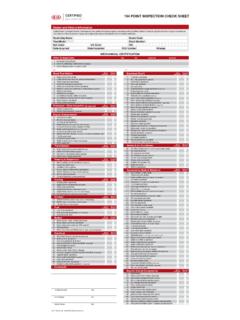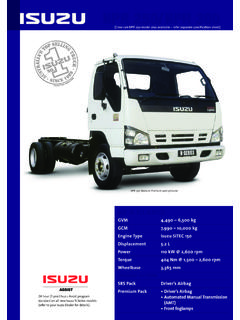Transcription of TABLE OF CONTENTS Sr. No Contents Page No.
1 TABLE OF CONTENTS . Sr. No CONTENTS Page No. 1. 1. Basic Textiles term Over lock Stitching 1. 2. 3. 3. Preparation for Stitching 5. 4. Types of Overlock Stitches Flat lock machine 7. 5. Parts of Flat lock Machine 8. 6. Stitches Types by Flat Lock Machine 8. 7. 9. 8. Threading to Flat Lock Machine 11. 9. Seam practice on different patterns Types of Needle used to swing Different fabrics 14. 10. 16. 11. Measurement Techniques Stitching Defects 19. 12. Maintenance of sewing machines 28. 13. 29. 14. Safety measures Page No 0 RSA DOCUMENT. Version 1. Basic Textiles terms Yarn Basic raw material for weaving Type of Single ply, double ply and multiply yarn Yarn count Defines thickness of yarn. Higher the count, finer the yarn Warp Lengthwise yarn in the fabric.
2 Pass from weavers beam to cloth roller Weft (filling) Widthwise yarn in the fabric. Inserted during picking Selvedge Edges of the fabric running lengthwise Woven Woven fabrics are made by using two or more sets of yarn interlaced Fabric at right angles to each other. Knitted The knitted fabric is a material with interlaced loops called Fabric also knitted fabric (example: knitwears). Sewing 1. Thread is a type of yarn used for sewing. Thread Page No 1 RSA DOCUMENT. Version 2. Over lock STITCHING. Stitching is the process of producing garments by joining various components of fabric, either woven or knitted. Over lock machine is a special purpose machine used for finishing edges and sometimes for seaming. Stitch types in this class are formed with one or more groups of threads and have general characteristics that loops from at least one group of threads pass around the edge of the material.
3 Sequence of Operations In Garment production Fabric inspection layering Pattern Making Cutting Fusing Stickering and bundling Stitching Buttoning and button holing Washing Ironing Finishing Packing Page No 2 RSA DOCUMENT. Version 3. IDENTIFICATION OF PARTS OF OVER LOCK MACHINE. Preparation for Stitching Before starting actual machining, you should check that the needle of the machine is of correct size, is sharp and correctly set. Thebobbin should be evenly set. Briefly, the various steps of prepreparation are: Winding the bobbin Upper Threading Drawing the bobbin thread Tension adjustments Pressure and feed adjustments . Overlock machine feeding system It utilizes two independently driven feed dogs. The stroke of each feed dog can be adjusted separately.
4 If the stroke of the front feed dog is greater, then the fabric may be gathering as it is sewn. If the rear feed dog has the greater stroke, then the fabric may be stretched to provide a more extensible seam. Page No 3 RSA DOCUMENT. Version Threading on Overlock machine Page No 4 RSA DOCUMENT. Version Threading on Overlock machine Step 1 Threading on Overlock machine Step 2. Threading on Overlock machine Step 3 Threading on Overlock machine Step 4. Threading on Overlock machine Step 5. Page No 5 RSA DOCUMENT. Version Types of Overlock Stitches 1. single thread overlock: One needle and one looper. Only used in home application. Has little effect on fabric drape. Unsuitable for seaming, because does not hold plies securely, causing seam grim when stressed 2.
5 Two thread overlock: One needle and one looper. Best for finishing seam edges and allowances. Has little effect on fabric drape, and rarely causes a pressing imprint. Frequently used for serging edges on men's slacks, lightweight fabrics. Unsuitable for seaming, because does not hold plies securely, causing seam grim when stressed. Page No 6 RSA DOCUMENT. Version 3. Three thread overlock: Stitch formed by interaction between vertical movement of needle and horizontal movement of two loopers. Stitch looks the same on both sides To make this stitch, the needle thread stitches the flies together when it interlocks with the under looped thread on the underside and upper looper thread on the top side. Used for finishing edges as a narrow, decorative, rolled edge on napkins and useful for sewing knits and woven.
6 4. Four thread overlock: It will stitch a chain stitch or a safety stitch as it stitches and overcasts seams. Two needles and two loopers. Can be converted to both two and three thread overlock All 4 threads are necessary to sew a serged seam. Suitable for sewing blouses, shirts, skirts, dresses, pants, lingerie, action wear, swimwear, and even sleepwear. 5. Five Thread Overlock A 2-thread chain stitch combined with a 3- thread overlock. 2 needles and 3 loopers. The left needle and lower looper form a 2- thread chain stitch. Page No 7 RSA DOCUMENT. Version The seam is very durable, particularly for wovens. A very wide seam width is created when the chain is serged with 2 or 3. thread stitch. Flat Lock Machine: Flatlock stitching is the stitching that looks like overlocking on both sides of a seam and is often used in swimwear, sportswear, on baby's clothes, or just as a decorative exposed seam.
7 It creates a seam that is flat and has the same appearance both inside and out. Elements in Stitching 1. Needle 2. Looper 3. Spreader Multi needle machine may have more than three needles. Page No 8 RSA DOCUMENT. Version Parts of Flat lock Machine Stitches Types by Flat Lock Machine Page No 9 RSA DOCUMENT. Version Threading to Flat Lock Machine Page No 10 RSA DOCUMENT. Version Threading on Flatlock machine Step 1 Threading on Flatlock machine Step 2. Threading on Flatlock machine Step 3 Threading on Flatlock machine Step 4. Start Stitching on Flat lock Machine Page No 11 RSA DOCUMENT. Version 5 SEAM PRACTICE ON DIFFERENT PATTERNS. Straight seams Straight seams end at a cross seam Straight seams with bartacking stitches Page No 12 RSA DOCUMENT. Version Short zigzag seams Curved seams in left and right sewing direction Spiral seams Page No 13 RSA DOCUMENT.
8 Version Sinusoidal seams Various decorative stitches of shoe branch Decorative stitching on an poket Page No 14 RSA DOCUMENT. Version Types of Needle used to swing Different fabrics Select the type of needle based on the textile construction ( knit vs woven), and the needle size is determined by the thickness of the thread and the weight of the fabric used for swing. There are two needle sizing system :American and European. American Needle sizes range from 8 to 19, and European sizes range from 60 to 120. Larger the number, the larger the blade of the needle. Page No 15 RSA DOCUMENT. Version Commonly used needles and their uses as below:- Needle Fabric Sizes Description Uses Ball-point Knits 70/10 This needle has a medium tip that is a 100/16 slightly more rounded than a universal needle and passes between the fabric threads instead of piercing them.
9 Ball- point needles ensure more even stitches on coarse and heavy knits and won't damage spandex, interlocks and other knits that snag or run easily. Sharp/ Finely 60/8 These needles feature a narrow shaft and Microtex woven 90/14 sharper point to pierce the threads of woven fabrics fabrics. Use for stitching smooth, finely woven fabrics, such as silk, chintz, lightweight faux suede and microfiber fabrics. Because these needles enable perfectly straight stitching, they're also ideal for heirloom stitching, topstitching, pintucks and edge stitching. Universal Knits or 60/8 Point is very slightly rounded for use on wovens 120/19 knits, but sharp enough to pierce woven fabrics. These needles are available in the widest size range. Use when stitching synthetic or natural wovens and knits.
10 Denim/ Heavy 70/10 These needles have a thick, strong shaft and Jeans wovens 110/18 a very sharp point. They are used for and stitching denim, canvas, duck and denims other heavy, tightly woven fabrics. They are also ideal for stitching through multiple fabric layers without breaking. Page No 16 RSA DOCUMENT. Version Determining the Right Needle for a Thread Here's a quick way to determine if the thread and the sewing machine needle are compatible: 1. Take half a metre of the thread being used on the machine and thread it through the eye of a loose needle. 2. Hold the thread vertically with the needle at the top. If the needle is too big, it will drop to the bottom of the thread If the needle is too small, it will stick at the top of the thread If the needle is the right size, it will slowly spiral to the bottom of the thread However, a larger-than-normal needle may have to be used to penetrate thicker fabric, or stitch over the top of pronounced or bulky seams.




